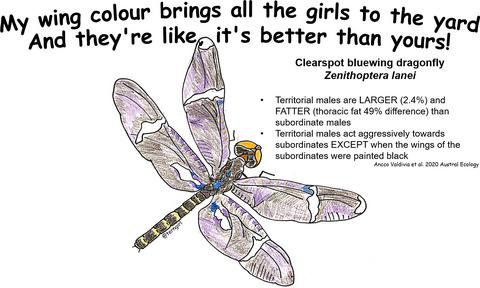当前位置:
X-MOL 学术
›
Austral Ecol.
›
论文详情
Our official English website, www.x-mol.net, welcomes your feedback! (Note: you will need to create a separate account there.)
Differences in size and energy content affect the territorial status and mating success of a neotropical dragonfly
Austral Ecology ( IF 1.5 ) Pub Date : 2020-04-07 , DOI: 10.1111/aec.12891 Fernando Geronimo Ancco Valdivia 1 , Estevão Alves-Silva 2 , Kleber Del-Claro 1, 3
Austral Ecology ( IF 1.5 ) Pub Date : 2020-04-07 , DOI: 10.1111/aec.12891 Fernando Geronimo Ancco Valdivia 1 , Estevão Alves-Silva 2 , Kleber Del-Claro 1, 3
Affiliation

|
In male odonates, both size and fat content are related to territory defence and mating success. Males that are larger and have higher energy reserves win relatively more disputes for territory and attract more females. Wing colour has also been regarded as a mechanism that influences agonistic behaviour between males, as wing pigmentation might be regarded as a sign of male quality. In this study, we analysed whether a set of male physical (body size and wing colour), physiological (body fat content) and behavioural (disputes between males) characteristics were involved in the territory defence and mating behaviour of the neotropical dragonfly Zenithoptera lanei Santos, 1941 (Anisoptera: Libellulidae). Males were characterised as territorial whenever they warded‐off other males and remained in the same place within the pond for two consecutive days. In general, these territorial males were larger and had more abdominal and thoracic fat, engaged in pursuits more frequently, spent more time on sexual behaviour and female guarding, and mated more in comparison to subordinate males. By evaluating whether the percentage of wing area covered by black ink influenced male behaviour, we found that territorial males tended to act aggressively towards other males whose wings were partially painted, and sexually towards females irrespective of wing area painted. In Z. lanei, both body size and fat content play a role in defining territoriality. By subduing competitors and dominating preferred locations within high‐quality sites, these males are likely to be visited by females and engage in mating.
中文翻译:

大小和能量含量的差异会影响新热带蜻蜓的领土地位和交配成功
在雄性奥多酸盐中,大小和脂肪含量都与领土防御和交配成功有关。体型较大,能量储备较高的男性在领土争端中赢得的竞争相对较多,并且吸引了更多女性。机翼颜色也被认为是影响雄性之间激动作用的一种机制,因为机翼色素沉着可能被视为雄性品质的标志。在这项研究中,我们分析了一组男性的身体(身体大小和翅膀颜色),生理(身体脂肪含量)和行为(男性之间的争论)特征是否参与了新热带蜻蜓Zenithoptera lanei的领土防御和交配行为。1941年,桑托斯(Anisoptera:Libellulidae)。每当雄性击退其他雄性并连续两天留在池塘内的同一地点时,它们就被视为具有领土特征。一般而言,这些领地男性较大,腹部和胸腔脂肪更多,更经常进行追逐,在性行为和女性守卫上花费更多的时间,并且与下属男性相比交配更多。通过评估黑色墨水覆盖的机翼面积百分比是否影响雄性行为,我们发现,领地雄性倾向于对其他部分涂有机翼的雄性采取侵略性行为,而对雌性则采取性行为,而与所涂翼型无关。在Z. Lanei,无论身材大小还是脂肪含量都在定义地区性方面发挥作用。通过征服竞争者并控制高质量地点中的首选地点,这些雄性很可能会被雌性拜访并进行交配。
更新日期:2020-04-07
中文翻译:

大小和能量含量的差异会影响新热带蜻蜓的领土地位和交配成功
在雄性奥多酸盐中,大小和脂肪含量都与领土防御和交配成功有关。体型较大,能量储备较高的男性在领土争端中赢得的竞争相对较多,并且吸引了更多女性。机翼颜色也被认为是影响雄性之间激动作用的一种机制,因为机翼色素沉着可能被视为雄性品质的标志。在这项研究中,我们分析了一组男性的身体(身体大小和翅膀颜色),生理(身体脂肪含量)和行为(男性之间的争论)特征是否参与了新热带蜻蜓Zenithoptera lanei的领土防御和交配行为。1941年,桑托斯(Anisoptera:Libellulidae)。每当雄性击退其他雄性并连续两天留在池塘内的同一地点时,它们就被视为具有领土特征。一般而言,这些领地男性较大,腹部和胸腔脂肪更多,更经常进行追逐,在性行为和女性守卫上花费更多的时间,并且与下属男性相比交配更多。通过评估黑色墨水覆盖的机翼面积百分比是否影响雄性行为,我们发现,领地雄性倾向于对其他部分涂有机翼的雄性采取侵略性行为,而对雌性则采取性行为,而与所涂翼型无关。在Z. Lanei,无论身材大小还是脂肪含量都在定义地区性方面发挥作用。通过征服竞争者并控制高质量地点中的首选地点,这些雄性很可能会被雌性拜访并进行交配。



























 京公网安备 11010802027423号
京公网安备 11010802027423号